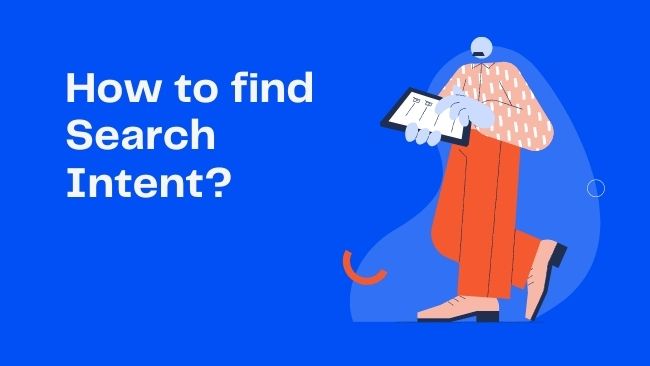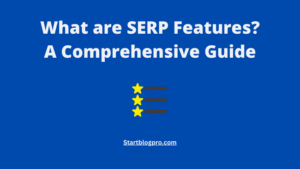Planning to start a new blog post? What is the first thing you do? Most will say “Keyword research“. You are right! But, to add extra punch to your content. You should include search intent optimization.
In this article, We will help you understand search intent and different types of intents. We also guide you on how to optimise your content for it.
What is the Search Intent In SEO?

Search intent is the reason behind the searcher’s query. It answers the “why” of the search query of the user. Other words that we use for it are keyword intent, user intent, audience intent or searcher intent.
When you make a search query in the search engine. Google. You are most likely be doing one of these actions (searchers “why”):
- Find information.
- Visit a website.
- Buy something online
Many people may be looking for the same thing but for a different reason. This reason is referred to as the search intent.
Let’s understand it with an example. Three users are searching for a book titled “Harry Potter”.
One user will be looking for a review (information) of the book. Another user would like to buy the book. And still, others may be searching for the official website of the book. So that he can find more books of the same genre.
Why is Search Intent Important?

Search intent is important because it directly affects Google’s primary ranking factors. These ranking factors are relevance, authority and user satisfaction. Google rewards the content that satisfies these ranking factors.
In the initial days, it was very easy to fool the search engines like Google. Bloggers and webmasters dominated these search engines like Google by stuffing a lot of keywords.
Not anymore, post rank brain Google update. Google has started to factor in the intent of the queries.
If your target keywords are matched with the intent. Your content rankings will be dramatically boosted. Let’s briefly discuss how the searcher’s intent optimisation helps to rank your content.
Improves Relevancy
If your keywords and content are aligned with the search intent. Your content will get more qualified clicks. Which in turn, improves your content’s relevance to the user’s search query or keywords. Google considers your content to be relevant to the keywords and the intent.
Improve Conversions
With the improvement in your content relevancy, your site starts getting qualified traffic. The qualified traffic always results in better conversions
Lower Bounce Rate
If your content is satisfying the search intent. The visitor will spend more time on your site. It will help you in bringing down the bounce rate of your site.
More Featured Snippets or Answer Boxes
Search intent optimisation leads to focussed content. You have direct answers to the most common issues/questions. These questions can be picked up by Google as featured snippets or answer boxes.
Improves Authority
If your content directly answers the common question of your users. Your content naturally has better relevancy to the user’s query. You drive more traffic and reduce the bounce rate of your site. Google starts recognising you as an authority on the subject.
I hope you are convinced about the importance of users’ intent. Make it a part of your content workflow. And include it in your next piece of content.
READ: How To Start A Blog?
Let’s now discuss different types of keyword intents.
What are the Common Types of Search Intent?

As we know, users use the search engine for any of these three types of searches –
- Finding information.
- Go to a website.
- Purchase a product.
These three actions refer to a specific type of intent. If you are yet not clear let me help you.
The common type of intents that you will encounter are:
Informational Intent
80% of the searches on the internet have informational intent. Users are looking for an answer to their questions. It can be a simple question or a more comprehensive guide. Google has brought information to our fingertips.
Examples of the informational search intent are:
- What is informational intent?
- Who is Neil Patel?
- Cafe near me
- Cricket Score
Navigational Intent
Approx 10% of the total search queries have a navigational intent. Here, the searcher is looking for a specific website. The intent of the user is to find a specific website and navigate to it.
Examples of navigational intent are
- Startblogpro
- Facebook login
- SEO guide backlinko
- Google keyword tool
Transactional Intent
Transactional intent consists of 10% of the total type of search queries. With the advent of online shopping, more and more people are shopping online. The search query that leads to a transaction has a transactional search intent.
Examples of transaction intent
- Buy iPhone X
- Bluehost discount
- LG washing machine price
- Udemy coupon
Commercial Intent
The commercial intent is the same as the transactional one. The user here is looking for more information like comparisons and alternatives etc.
Examples of commercial intent
- Best Laptop
- Yoast vs Rankmath
- Semrush review
- Top WordPress theme
How do I Find Search Intent?

You are now armed with the knowledge of different types of intents. You may be asking “How to identify keyword intent?”.
First thing, carry out the keyword research. Select the keywords that you want to rank for. Now enter the keywords one by one in the Google search engine and analyse the SERP results.
Analysis of search engine result pages (SERP) will give you clue’s about the intent of keywords. The searchers use specific types of words. These words/keywords will help you determine the intent behind them.
Go through the search engine result pages (SERP). What type of results shows up? Is there a common theme in the results? Always look for the intentions behind the keyword search. This exercise will help you become better at finding the keyword intent.
A few words and modifiers could help you determine the user intent.
Let’s start with transactional intent. The keywords with transactional intent will have words like:
- product names
- buy
- discount
- deal
Keywords with informational intent may contain words
- what is
- Why
- how to
- information
- best way to
I have listed down key points that will help you find the search intent of the content.
1. Analysing the SERPs
To find the intent of your keywords, plug in the keywords one by one in Google. Scan and analyse the search engine result pages (SERP).
What types of search results do you find? Do the results consists of blog posts with “How to” or “What is” stuff. Or it’s a listing of product pages.
This will give you a good idea about the intent of your keywords. The content has to be optimised accordingly.
2. Run a Survey
You can run a small survey to understand the search intent of your audience. The survey can give you valuable insights and help you find out more about your audience.
3. Analyse Competition
A fairly straightforward method. Spy on your competitor’s content targeting similar keywords. What type of content they are writing on the same topic?
How to Optimize Content for Search Intent

You have finished writing a brand new article and going to press the publish button. Wait!!! Are You Optimized for Search Intent?
Your next question will be how do I optimize for search intent?”.
We will discuss the optimization of each type of search intent. Let’s start with the type of intent with the highest number of search queries.
Informational Intent Optimization
As you know, this type of search query is for seeking information.
Your content should answer commonly asked questions directly or in the form of FAQs.
Your content should be targeting search queries like
- What is…..
- How to……
- Price of…..
- Age of…
- history of…
You should structure the content properly. This will help you win the featured snippets.
The featured snippets appear at the top of the search engine result pages (SERP) at rank #0. Driving more traffic to your content.
Use headings, subheadings, ordered and unordered lists etc to improve the structure of your content
Transactional Intent Optimization
Transactional intent optimization aims to convert the visitor into a customer. Your content should target the keywords with transactional intent.
The following points should be kept in mind when creating content for transactional intent pages.
- Show the benefits of making the transaction and the process of transacting.
- Use images to validate your point or product benefits. The message should be short and to the point.
- Only provide the information required for conversion. Avoid informational overload.
- Build trust with your content, and appeal to the emotions of the users. You should try to answer their common doubts and concerns.
- You should have a clear call to action (CTA). CTA should be eye-catching and should immediately draw the visitor’s attention.
Offering a product to someone looking for information or vice versa will never work.
What are the Effective Content Types for each Search Intent?

The informational intent content provides the top-of-the-funnel content. The effective types of content for informational search queries are:
- Blog post.
- List-post
- Tips post.
The aim transactional intent content page is to help the customer in making the transaction. The most effective type of content for transactional queries are
- Pricing Page
- Product Page
- Category Page
- Recommended Tools page
Conclusion
The search intent is the specific end result behind the user’s query. It refers to the “why” behind the query.
It is an important part of content planning. Post Google’s Rankbrain update, the search engine looks for the intent behind the user’s search query.
The major types of search intents are:
- Informational Search Intent
- Navigational Search Intent
- Transactional Search Intent
- Commercial Search Intent
We covered, how to find the search intent by analysing the SERPs and other additional methods. Next, we discussed how to optimize the content for the search intent.
We briefly covered the effective content types for each type of search intent.
What are your views on the topic? How do you optimize the content for search intent?





Pingback: 29 Best Content Writing Tools For SEO in 2022 | StartBlogPro
Pingback: How To Learn SEO Free - Beginners Guide | StartBlogPro
Pingback: What are Meta Description And How to Optimize them for SEO? | StartBlogPro
Pingback: How to Start a Fashion Blog and Make Money? | StartBlogPro
Your passion for this topic shines through in your writing It’s clear that you put a lot of effort and thought into your posts Thank you for sharing your knowledge with us
Your positive and uplifting words are like a ray of sunshine on a cloudy day Thank you for spreading light and positivity in the world